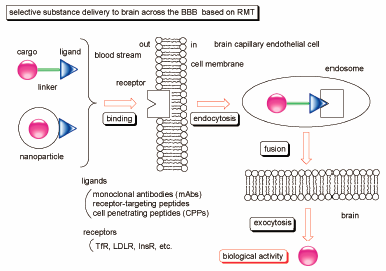- 著者
- Toshihiko Tashima
- 出版者
- The Pharmaceutical Society of Japan
- 雑誌
- Chemical and Pharmaceutical Bulletin (ISSN:00092363)
- 巻号頁・発行日
- vol.68, no.4, pp.316-325, 2020-04-01 (Released:2020-04-01)
- 参考文献数
- 59
- 被引用文献数
- 23 55
Discriminatory drug delivery into target cells is essential to effectively elicit the drug activity and to avoid off-target side effects; however, transporting drugs across the cell membrane is difficult due to factors such as molecular size, hydrophilicity, intercellular adhesiveness, and efflux transporters, particularly, in the brain capillary endothelial cells. Drug delivery into the brain is blocked by the blood–brain barrier (BBB). Thus, developing drugs for the central nervous system (CNS) diseases remains a challenge. The approach based on receptor-mediated transcytosis (RMT) can overcome this impassable problem at the BBB. Well-designed molecules for RMT form conjugates with the ligand and drugs via linkers or nanoparticles. Cell penetrating peptides (CPPs), receptor-targeting peptides, and monoclonal antibodies (mAbs) are often used as ligands. The binding of ligand to the receptor on the endothelial cell surface induces endocytosis. Existing exosomes comprising the conjugates move in the cytoplasm and fuse with the opposite plasma membrane to release them. Subsequently, the transcytosed conjugate-loaded drugs or released drugs from the conjugates elicit activity in the brain. As receptors, transferrin receptor (TfR), low-density lipoprotein receptor (LDLR), and insulin receptor (InsR) have been used to intendedly induce transcytosis. Presently, several clinical trials on CNS drugs for Alzheimer’s and Parkinson disease are hindered due to poor drug distribution into the brain. Therefore, this strategy based on RMT is a promising method for CNS drugs to be transported into the brain. In this review, I introduce the practicality and possibility of drug delivery into brain across the BBB using RMT.
